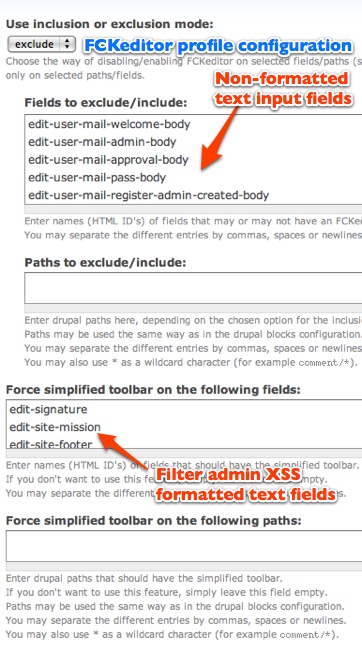Dries said (again) in his State of Drupal keynote this past week that a whole lot of people want WYSIWYG editors in Drupal. He also highlighted FCKeditor as the most popular one used for this job in the Drupal community (based on call-home data from Update Status module). So you'd say this is just too easy, move FCKeditor to core and we are done. Well, going the simple and quick way would just alienate those from RTEs (another nice acronym for these editors), because these editors are just too aggressive when it comes to pushing themselves to your face.
 The assumption in these editors is to treat all textareas as fields with HTML input by default, so you'll obviously need the HTML editor on them. But this is not the case. In previous times, if you installed an RTE, and went to a block's configuration page, the textarea where you can provide a list of paths on where the block will show/hide was taken over by the RTE. Through time, the RTE authors realized this is a problem and built in tools to limit their reach. If you look FCKeditor's profile editing interface (image on the right), you'll find settings to exclude certain form item IDs from FCKeditor's work. But who knows the form IDs? Well, FCKeditor authors built a tool which tells you about the form IDs on forms, eg. on the block configuration page, it says: The ID for excluding or including this element is: edit-pages - the path is: admin/build/block/configure/user/1. Then if you need to modify your configuration on this field, you need to remember these values, go over to the linked "excluding or including" page and alter the list of items there.
The assumption in these editors is to treat all textareas as fields with HTML input by default, so you'll obviously need the HTML editor on them. But this is not the case. In previous times, if you installed an RTE, and went to a block's configuration page, the textarea where you can provide a list of paths on where the block will show/hide was taken over by the RTE. Through time, the RTE authors realized this is a problem and built in tools to limit their reach. If you look FCKeditor's profile editing interface (image on the right), you'll find settings to exclude certain form item IDs from FCKeditor's work. But who knows the form IDs? Well, FCKeditor authors built a tool which tells you about the form IDs on forms, eg. on the block configuration page, it says: The ID for excluding or including this element is: edit-pages - the path is: admin/build/block/configure/user/1. Then if you need to modify your configuration on this field, you need to remember these values, go over to the linked "excluding or including" page and alter the list of items there.
There are a couple of flaws with this approach:
- End users need to deal with (internal) form item IDs to configure their site for forms which are not covered by the default settings.
- What guarantees that "edit-pages" will not be used as a form ID for HTML input in another form? Nothing. If we block it out, we block it out in all forms.
- Blacklisting keeps textareas open to FCKeditor by default, so if a contrib module comes requiring text input in a field, there is no way to tell RTEs not to process that field, the user will face the pushy RTE and submit a bug against the contrib module such as http://drupal.org/node/293502 (and will get users hack as hell).
- If this all was not enough, FCKeditor also has a simplified toolbar view, which is used for text input using the filtered XSS admin processor (when input format is not selected, but some HTML is still allowed). Again end users set up which textareas are using this method (beyond some defaults included). How they get to know that? Well, trial and error, or they need to look into the code.
All these ugly hassles for the end user, while we programmers know exactly that input from a textarea will be plain text (eg. email text, a list of paths), passed through filter XSS admin or filtered via one of the input filters set up. Not only that, but we know if a textarea is passed through input filters and the particular input filter used escapes HTML, it is pointless to display an RTE for HTML. So it is not only the page the textarea was displayed on, it is not only the ID of the textarea, it is also the properties of the selected input format for that textarea (when applicable) which defines whether FCKeditor should be there or not.
These are all things programmers can tell Drupal about without any user interaction, completely removing these settings and making WYSIWYG editing really seamless for the user. How do we tell Drupal what type of input is on the textarea? Well, we tell it to use a specific format. There are two competing proposals on how this should work, both in the issue: Textarea with input format attached. If you care about WYSIWYG editors in Drupal core (for Drupal 7), please help do quality reviews and provide feedback on the approaches proposed. This is a prerequisite to making RTEs integrate seamlessly to Drupal.
 Drupal is very flexible and this makes integrating an RTE harder compared to one-purpose systems. First I tried to deliver a solution for RTEs to identify the form fields to attach to. For this to work, we need input format metadata attached to form elements, which is
Drupal is very flexible and this makes integrating an RTE harder compared to one-purpose systems. First I tried to deliver a solution for RTEs to identify the form fields to attach to. For this to work, we need input format metadata attached to form elements, which is